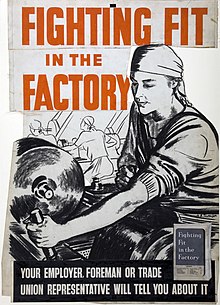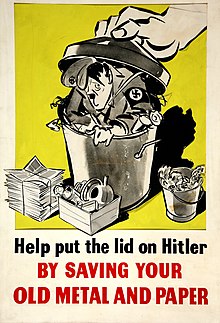
The term "home front" covers the activities of the civilians in a nation at war. World War II was a total war; homeland military production became vital to both the Allied and Axis powers. Life on the home front during World War II was a significant part of the war effort for all participants and had a major impact on the outcome of the war. Governments became involved with new issues such as rationing, manpower allocation, home defense, evacuation in the face of air raids, and response to occupation by an enemy power. The morale and psychology of the people responded to leadership and propaganda. Typically women were mobilized to an unprecedented degree.
All of the powers used lessons from their experiences on the home front during World War I. Their success in mobilizing economic output was a major factor in supporting combat operations. Among morale-boosting activities that also benefited combat efforts, the home front engaged in a variety of scrap drives for materials crucial to the war effort such as metal, rubber, and rags. Such drives helped strengthen civilian morale and support for the war effort. Each country tried to suppress negative or defeatist rumors.

The major powers devoted 50–61 percent of their total GDP to munitions production. The Allies produced about three times as much in munitions as the Axis powers.
| Country/Alliance | Year | ||||||
|---|---|---|---|---|---|---|---|
| Average 1935-39 |
1940 | 1941 | 1942 | 1943 | 1944 | Total 1939–44 | |
| 0.3 | 1.5 | 4.5 | 20.0 | 38.0 | 42.0 | 106.3 | |
| 0.5 | 3.5 | 6.5 | 9.0 | 11.0 | 11.0 | 41.5 | |
| 1.6 | 5.0 | 8.5 | 11.5 | 14.0 | 16.0 | 56.6 | |
| Allies Total | 2.4 | 10.0 | 20.0 | 41.5 | 64.5 | 70.5 | 204.4 |
| 2.4 | 6.0 | 6.0 | 8.5 | 13.5 | 17.0 | 53.4 | |
| 0.4 | 1.0 | 2.0 | 3.0 | 4.5 | 6.0 | 16.9 | |
| Axis Total | 2.8 | 7.0 | 8.0 | 11.5 | 18.0 | 23.0 | 70.3 |
Source: Goldsmith data in Harrison (1988) p. 172
| Country | Year | |||||||
|---|---|---|---|---|---|---|---|---|
| 1937 | 1939 | 1940 | 1941 | 1942 | 1943 | 1944 | 1945 | |
| 100 | 107 | 109 | 111 | 108 | 99 | 93 | 78 | |
| 100 | 108 | 117 | 108 | 105 | 95 | 94 | 85 | |
| 100 | 96 | 103 | 108 | 116 | 115 | 118 | 122 | |
Source: Jerome B Cohen, Japan's Economy in War and Reconstruction (1949) p 354